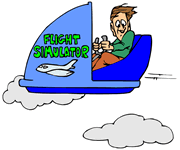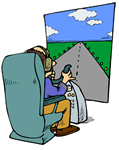Virtual Experiences:
|
||||||||
Virtual Field Trips
Go to Coal Creek Virtual Field Trip to see virtual field trips created by elementary children. |
||||||||
For more ideas for all ages, go to Teacher Tap: Digital and Virtual Field Trips, Museums, Libraries. Use a web template to create a virtual experience.
|
||||||||
Simulations
There are many types of simulations. Physical simulations involve students in using objects or machines such as microscopes or airplanes. Procedural simulations involve a series of actions or steps such as medical diagnosis or frog dissection. Situational simulations involve critical incidents within particular settings such as interactions with customers. Process simulations involve decisionimaking skills related to topics such as economics, genetics, or geology. Students must choose among alternative paths. |
||||||||
|
||||||||
Tools for Virtual Experiences
Live video cams, expert discussions, maps, and photographs can all help bring the outside world alive.
Cams
WebCams + BlogsIncreasingly, webcams are being combined with blogs. For example, WildCam Africa from National Geographic has a place where students can ask questions as they watch the cam as part of an ongoing blog. You can turn any webcam into this type of project by using a blog or even a journal activity. The Internet provides access to live events and activities not available in local areas. For example, FalconCams are used by people around the world to monitor the activities of these beautiful birds. Many classrooms are participating in projects that get students actively involved in real-world science through observing these live cameras and monitoring the blogs. For example, a fifth grade group in California maintains a website for their falcon project. It included links to Native American folklore, student journal entries, activities, and even an email reply from the author of Frightful's Mountain, Jean Craighead George. Consider ways to provide students with experiences that would not be possible without technology. For example, students can use an incubator simulation see learn about the gestation of chickens.
|
||||||||
Developed by Annette Lamb, 3/06. |
 We'd love to take our children on a trip to the great art and science museums of the world, explore the ocean bottom, or visit the earth's core. Whether it's the cost of a bus trip or the danger of a trip into outer space, sometimes a virtual field trip or simulation is more realistic.
We'd love to take our children on a trip to the great art and science museums of the world, explore the ocean bottom, or visit the earth's core. Whether it's the cost of a bus trip or the danger of a trip into outer space, sometimes a virtual field trip or simulation is more realistic.  Experiment!
Experiment! Turn a simple website into a virtual field trip by designing engaging off computer activities including tickets, maps, and travel itineraries. Many virtual fieldtrips are produced by professionals; however also explore virtual field trips made by kids, for kids.
Turn a simple website into a virtual field trip by designing engaging off computer activities including tickets, maps, and travel itineraries. Many virtual fieldtrips are produced by professionals; however also explore virtual field trips made by kids, for kids. Simulations help students apply their skills to "real life" situations by providing an environment to manipulate variables, examine relationships, and make decisions. They are generally used after initial instruction as part of application, review, or remediation.
Simulations help students apply their skills to "real life" situations by providing an environment to manipulate variables, examine relationships, and make decisions. They are generally used after initial instruction as part of application, review, or remediation. How can you bring the world into the classroom?
How can you bring the world into the classroom? 